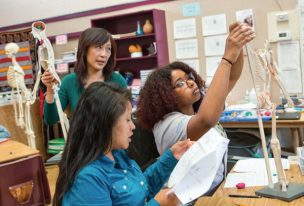Teachers’ Quest for Powerful Real-Time Data
“What does a successful science journal look like in second grade?”
“What do I hope this partner reading conversation sounds like?”
“What data would indicate that my students have really internalized the science concept we are studying?”
These are the kinds of questions that our teacher scholars grapple with in their collaborative Mills Teacher Scholars work sessions. On the surface, these questions may seem straightforward. But in practice, seeking thoughtful answers to questions about student understanding of content involves delving in to messy issues. Perhaps the most common struggle our teachers scholars face is teasing apart evidence of student understanding from evidence of a student’s ability to follow directions. Upon looking closely and reflecting with colleagues teachers discover that a well scaffolded assignment may yield more data about students’ ability to follow directions than about their understanding of the key concepts. So how can we figure out what students really understand?
In a Mills Teacher Scholars session facilitated last month by teacher scholar leaders from Oakland Unified, I listened as teachers went around the circle sharing the focus of their inquiries and what data might provide useful information. These teachers wanted to know how their students were, or were not, progressing towards the established learning goal.
Several teachers shared that they had changed their routine data source from their initial idea. In each case, the teacher wanted to know what the students were thinking and which concepts the students understood. These teacher scholars realized that when their assignment provided teacher-created sentence frames, and teacher-designed structures for thinking, the results didn’t show student thinking. Rather, they showed successful completion of a carefully designed task. But whether the student really understood the ideas they were expressing was not at all clear.
One second grade teacher initially used, as her routine data source, student science journal entries written using teacher-designed sentence frames. This teacher changed her routine data source to be interviews with focal students in which they talked about the conclusions they had drawn and the evidence they had used that supported those conclusions.
Another teacher began her inquiry by using, as her routine data source, information about how many students had completed their learning center written work. Now she has moved to using recordings of partner conversations at the reading center to find out what kind of learning conversations partners are (or are not) having.
Yet another teacher began by looking at Accelerated Reader test scores. (Accelerated Reader is a computer based reading assessment widely used for monitoring reading progress). She realized that the scores were not telling her much about how the students were interacting with the text, and she changed her routine data source to book talks with her focal students.
Each of these teacher scholars went beyond checking for completion and recording numerical scores to implementing practices that allowed them to find out how their students are thinking.
Through their Mills Teacher Scholars work, teachers consistently create new opportunities for students to express their understanding of the key concepts. Teacher scholars then use these powerful data to guide their classroom instruction. Creating time and support for teachers to collect, analyze, and share these real-time data is an essential component to transforming classrooms into places where a diverse group of students find opportunities for deepened learning.



